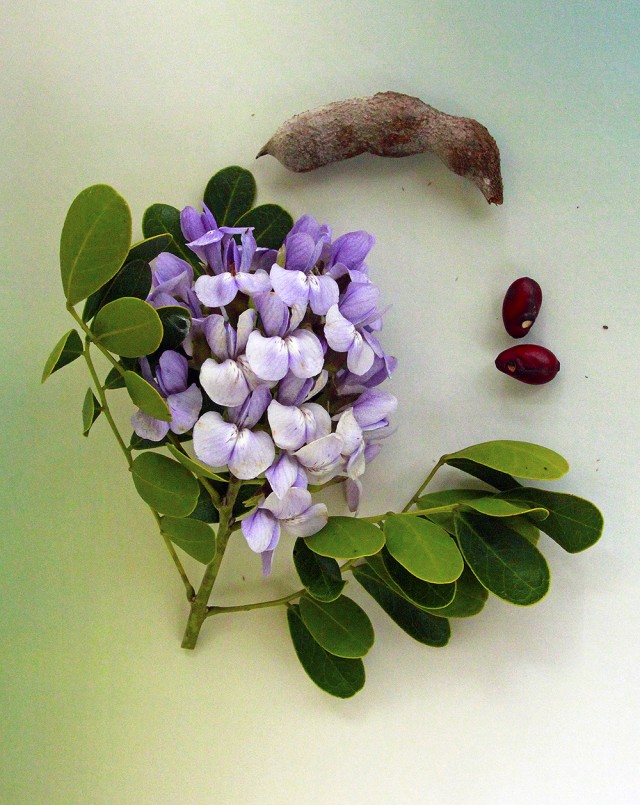
A flower cluster of Texas Mountain Laurel consists of dozens of little purple bonnet-shaped blossoms. The fragrance is heady and sweet. Some people say the flowers smell like grape soda! The bright red, shiny seeds form inside a tough woody pod. Historically, the seeds were used as beads for decorating clothing and may have had ritualistic value. Robert Benson photo.
04 Mar 2016 – Texas Mountain Laurel is a Breath of Spring
The wildflower season is beginning. I am sure you have noticed. There are stands of Indian Paintbrushes and patches of hot pink phlox along the roadsides. And that lovely Texas native, Mountain Laurel, is blooming.
Texas Mountain Laurel is usually classified as a shrub, although it can grow to a height of a small tree. Its glossy evergreen leaves make it a valuable landscaping plant, even when it is not blooming. And when it is blooming it is spectacular!
Right around the first of March in South Texas, the Mountain Laurel “bursts forth in gorgeous purple blossoms, which resemble Wisteria, proof to its many admirers that in bloom the plant is unequaled in beauty among our native Texas shrubs.” The fragrance is also wonderful. I am inclined to agree with the botanist Ferdinand Lindheimer that the scent was “very nearly the fragrance of violets.” Although, the first time I smelled Texas Mountain Laurel, I was reminded of grape soda and kind of grape-flavored children’s Tylenol.
That artificial grape flavoring is actually a chemical compound known as methyl anthranilate. It is synthesized and widely used as an ingredient in perfumes as well as a flavoring. It is not so much a “taste” as it is a smell. Open a package of grape Kool-Aid. You don’t even have to taste it to recognize that strong, fruity “grape” smell. That smell is due to methyl anthranilate, which at full concentration smells very grapey. However, to most of us growing up in Texas, it doesn’t smell like real grapes! Why? This is because we are mostly used to green grapes and red grapes and even mustang grapes, and they do NOT have any natural methyl anthranilate in them. At 25 parts per million, the diluted chemical has a “sweet, fruity, Concord grape-like smell with a musty and berry nuance.” Apparently, Concord grapes and other grapes in Vitis labrusca naturally contain the chemical.
Not everybody likes the fragrance of Texas Mountain Laurel. In their Native Texas Plants (1997) Sally and Andy Wasowski state that “the scent is icky sweet on a hot day.” I guess we are fortunate that the plant blooms so early in spring (before the days have gotten too hot!) Anyway, I love to breathe in the odor of fresh Texas Mountain Laurel. It smells like spring to me.
In his book, Remarkable Plants of Texas (2009), Matt Turner writes “Two things are remarkable about this plant: the luxurious flowers and the conspicuous seeds.” Almost everybody is familiar with the seeds. They are hard, bright red, and about the size of small marbles. They are sometimes called “mescal beans” which is unfortunate. They are beans and Texas Mountain Laurel (Sophora secundiflora) is indeed in the bean family. But they are not related to mescal. Mescal is a Mexican name for a distilled alcoholic beverage made from the fleshy leaf bases of an agave plant. Somehow, mescal became the general name for all intoxicants. Even peyote, a hallucinogenic cactus, was called mescal for a while. The psychoactive substance in peyote is called mescaline to this day.
Matt Turner suggests that the name “mescal bean” became linked to Sophora secundiflora seeds by association. Native American tribes would occasionally partake of peyote during shamanistic rituals. The medicine men’s bags also contained the hard red beans of Sophora, which may, or may not, have also been ingested during the rituals. It is likely they were not. The beans, and all parts of the Sophora plant are toxic, but “not generally considered hallucinogenic.” In fact, one botanist asserted that a half a bean would put you to sleep for two or three days, but “a whole bean would kill a man.”
All of this leads most writers to assume that the Texas Mountain Laurel seeds were venerated for their color and hardness. They could be made into beads, jewelry, and used to decorate clothing and other items. Perhaps, in a world without industrially made beads, these red, shiny beans had “few equals among natural objects for decoration” and if they were “ritualized and considered hallucinogenic” the Sophora beans were even more attractive.
It is certain that the Texas Mountain Laurel seeds were a hot trade item. Although the plant only grows in the caliche soils of South Texas, the Hill Country and west to parts of New Mexico and into arid Mexico, they have been found on items made by North American Indian tribes as far away as the Great Plains. Shirts, skirts, leggings, pouches, and jewelry from the Dakota Sioux, the Ojibwa, the Winnebago and even the Montana Blackfoot often were decorated with the red bean-beads.
Two other uses for the Sophora beans are documented. One is the “hot bean game” played by children (mean children!) who heat up the beans by rubbing them vigorously on the sidewalk and then touching the hot bean to another child. Did you ever play that game? (I am not telling.) Another more obscure use was made of the beans by some Mexican tribes. They crushed the beans and fed them to their neighbor’s chickens. “The chickens became stupefied and then unconscious, and were easily captured without commotion, thus acquiring new owners” wrote archaeologist George C. Martin in 1933.
We have a feral chicken in our yard. She has resisted capture by my husband and the coyotes for several weeks. I think we might try the red bean trick!
If you would like to offer comments, please click through to the discussion page
